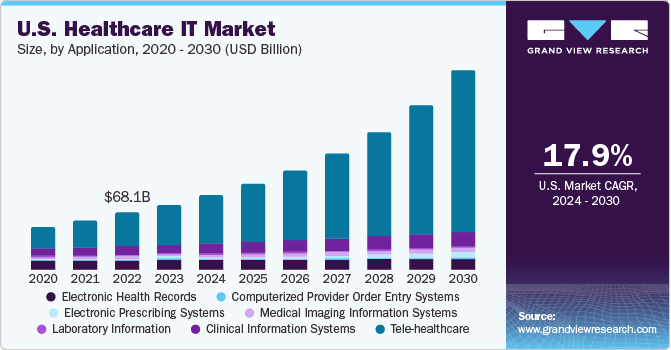With a constant demand for IT workers, one of the fastest-growing professions in the healthcare sector is information technology.
Organizations in the healthcare industry strive to deliver more patient-centered care and evidence-based procedures while lowering costs, preventing medical errors, and enhancing the clinical quality of care and patient safety.
Healthcare IT experts make it simpler for firms to achieve the aforementioned objectives and other corporate objectives. Naturally, recruiting managers in such businesses want a steady influx of qualified healthcare IT specialists.
According to a recent analysis by Grand View Research, Inc., the size of the worldwide healthcare IT market is anticipated to reach USD 1,305.1 billion by 2030 and to grow at a CAGR of 29.3% during the projected period.

Source: Grand View Research
Therefore, having a solid healthcare IT recruitment strategy in place has become more crucial than ever for HR leaders.
4 Tips To Slay Your Healthcare IT Recruitment
Tip #1: Set your goals straight by planning ahead
According to a recent study, failing to plan has put unnecessary pressure on HR professionals to complete the hiring cycle at the last minute, leading to bad hires in the past.
Seventy-five percent of HR Leaders admitted to making mistakes in some of their hiring decisions. The number needs to decrease with each poor hire costing $15,000.
Therefore, given the high stakes connected with a declining healthcare workforce and the high-pressure environment of the healthcare recruitment market, planning has recently become the greatest technique to attract healthcare IT specialists.
Follow these tips when you create your data-driven recruitment strategy:
- Make the most of your hiring technology’s candidate and staff data.
- Determine the best candidate engagement tactics for your in-demand positions.
- Create a hiring roadmap for both the short- and long-term.
Furthermore, you shouldn’t limit your strategy only to the above suggestions. Plan and map your extensive talent pool as part of your recruitment efforts to move forward.
Run your healthcare IT job applicant outreach materials among peers from different backgrounds who are somehow connected to a healthcare IT organization. When conducting research or developing email campaigns, gather all of these findings and consolidate the data into a document or spreadsheet for convenient access.
You can use analytical tools to dig down on the candidate pool to learn where underrepresented prospects are located or which top healthcare organization they choose. The AI algorithms can then locate individuals that meet your requirements.
Tip #2: Understand what exactly your competitors are doing to leverage your tech talent pool
Since healthcare IT professionals typically have lengthy employment contracts, healthcare recruiters must be aware of what their rivals are doing and possess the intelligence necessary to identify passive talent.
Employer branding is a prominent topic in the healthcare recruitment industry for just this reason.
Join online professional communities (such as Facebook groups for nursing or medical residents) to stay up to date on where and how young professionals are interviewing, their feedback, when other institutions are making offers, and the nature of compensation discussions. After that, you can use this information to revise your procedures and outperform rivals.
Additionally, Market Insight tools can provide you with a thorough breakdown of the number of professionals that are currently employed by other Healthcare organizations in your area.
For example:
Create a talent roadmap to better manage a shortage of healthcare personnel at your company by knowing when and where to target the best people.
Start with talent market data to find recurring patterns among employees in a given role. This could include information on their normal term of employment with a company, the percentage of people who leave their jobs after a set amount of time, or even the areas they might be moving to.
Use this information to generate a report that clearly outlines the steps you need to do at various hiring stages.
To respond to the who, what, and were in the talent plan, leverage market insights. The report insights include:
- In the last 12 months, how many persons with a particular job title have left their positions?
- How long had they been in the company?
- What was their typical market value?
- Which healthcare organization did they work for?
When talking about Healthcare IT recruitment, George Cobb, Talent sourcer at the Arkansas Children’s Hospital, said, “By replying to these questions, you can choose when to get in touch with those who usually quit their jobs after three years.” He continued, “I may also adjust my recruitment strategy if I discover that individuals with fewer than five years of experience are likely to examine options by the time his next requisition opens.“
Tip# 3: Get your sourcing on point by looking at the Right Places
When seeking the most competent Healthcare IT professionals, the majority of HR managers will look at general areas. LinkedIn, Indeed, and other traditional job sites are great places to look for top-notch computer workers. The most talented software engineers can be located in other locations that serve as global hubs for the industry. These consist of:
- GitHub
One of the most well-known online groups for programmers, software engineers, and other IT specialists is GitHub. On this unique hosting platform, programmers from all over the world can collaborate on projects and store their work.
Whether you’re looking for more information about a potential candidate or screening potential future hires, GitHub is a terrific place to find the best software professionals.
- AngelList
When companies are looking for the most talented people in the tech industry, they frequently turn to Angellist. Since its humble beginnings as a job portal in 2010, it has grown into a huge global network where entrepreneurs may get in touch with angel investors and hire competent staff. Developers with AngelList profiles either work for startups already or are looking for jobs at smaller companies.
- Stack Overflow
Another great place to find talent for efficient software developer hiring is Stack Overflow. It is a knowledge-sharing platform that works like a question-and-answer forum to encourage online communication between IT experts, company owners, and tech companies.
It has been compared to a cross between Reddit and a wiki for IT specialists due to users’ ability to edit their responses and upvote or downvote other users’ responses.
Tip# 4: Utilize Technology to Create a Workforce Planning Strategy
One of the main impediments to the healthcare sector is employee burnout. Healthcare recruiters must be ready to anticipate long-term needs to ensure that your firm can avoid overworking current employees.
Create a long-term hiring strategy to guarantee that your talent pipelines can meet future demands, such as filling skills gaps or assembling a backup staff for emergencies. Running data through your hiring software might help you foresee how healthcare prospects for a certain post may advance within the company throughout a specified period.
You may utilize your ATS, for instance, to find out how long employees stay on average at your company or whether a promotion or flexible work schedule supports longer employment terms.
By utilizing the tactics mentioned above and best practices, businesses may attract and keep the world’s greatest healthcare IT experts.
In addition to attracting and hiring the right people, don’t forget that hiring requires commitment. Contact our healthcare IT recruiters today to learn more about finding the most remarkable healthcare IT specialists in a lot less time.
